Wingspan 68 m Weight 172,400 kg Fuel capacity 193,600 L | Length 75 m Range 11,705 km | |
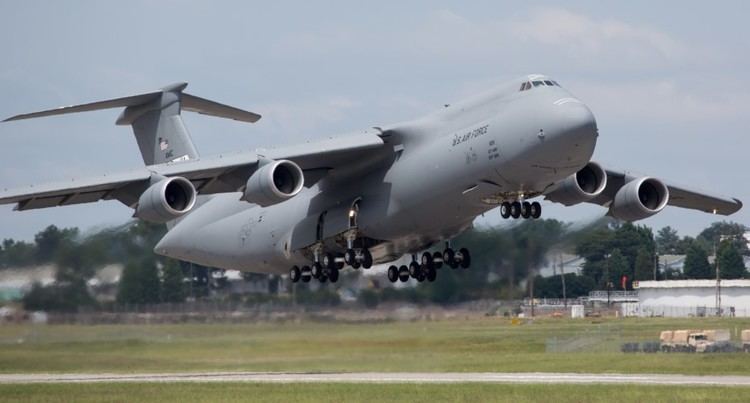 | ||
Manufacturers Lockheed Corporation, Lockheed Martin | ||
Mighty u s military aircraft lockheed c 5 galaxy documentary 2016 new
The Lockheed C-5 Galaxy is a large military transport aircraft originally designed and built by Lockheed, and now maintained and upgraded by its successor, Lockheed Martin. It provides the United States Air Force (USAF) with a heavy intercontinental-range strategic airlift capability, one that can carry outsize and oversize loads, including all air-certifiable cargo. The Galaxy has many similarities to its smaller Lockheed C-141 Starlifter predecessor, and the later Boeing C-17 Globemaster III. The C-5 is among the largest military aircraft in the world.
Contents
- Mighty u s military aircraft lockheed c 5 galaxy documentary 2016 new
- CX X and Heavy Logistics System
- Into production
- Restarted production and development
- Overview
- Operational history
- C 5A
- C 5B
- C 5C
- C 5 AMP and C 5M Super Galaxy
- L 500
- C 5 Shuttle Carrier
- Operators
- Incidents and accidents
- Notable accidents
- Aircraft on display
- Specifications C 5B
- References
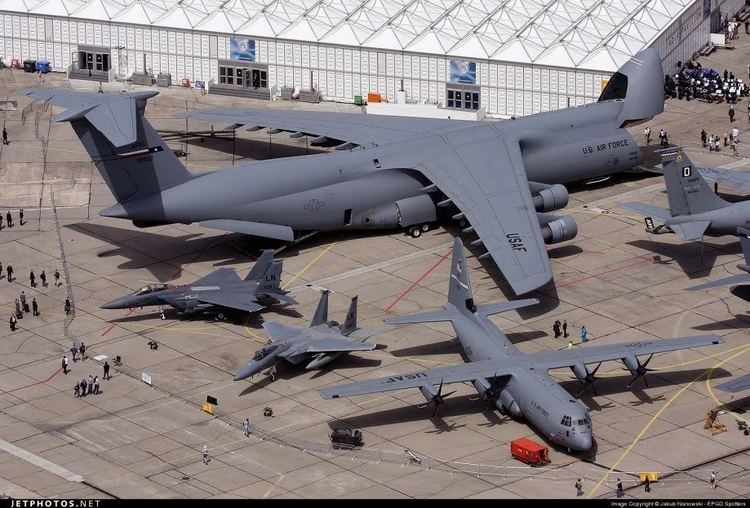
The C-5 Galaxy's development was complicated, including significant cost overruns, and Lockheed suffered significant financial difficulties. Shortly after entering service, cracks in the wings of many aircraft were discovered and the C-5 fleet was restricted in capability until corrective work was completed. The C-5M Super Galaxy is an upgraded version with new engines and modernized avionics designed to extend its service life beyond 2040.
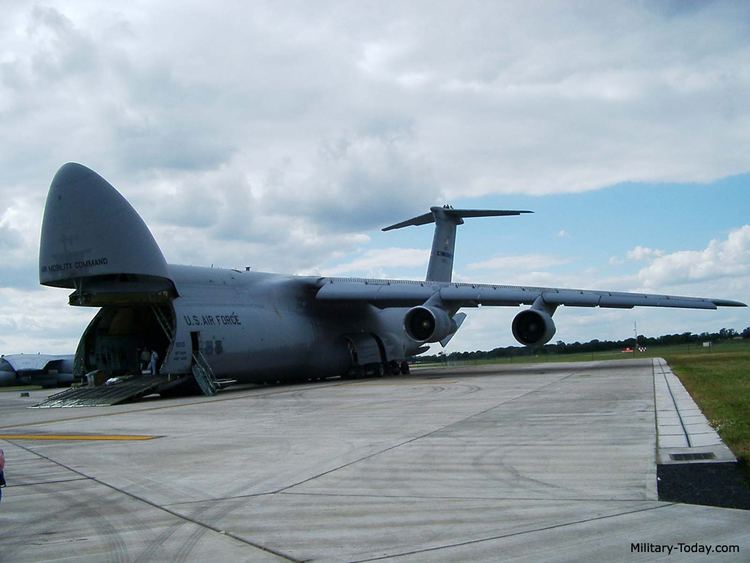
The USAF has operated the C-5 since 1969. In that time, the airlifter supported US military operations in all major conflicts including Vietnam, Iraq, Yugoslavia and Afghanistan, as well as allied support, such as Israel during the Yom Kippur War and operations in the Gulf War. The Galaxy has also been used to distribute humanitarian aid and disaster relief, and supported the US Space Shuttle program.
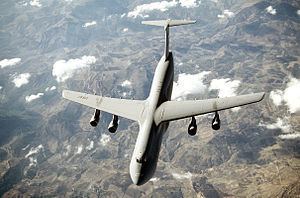
CX-X and Heavy Logistics System
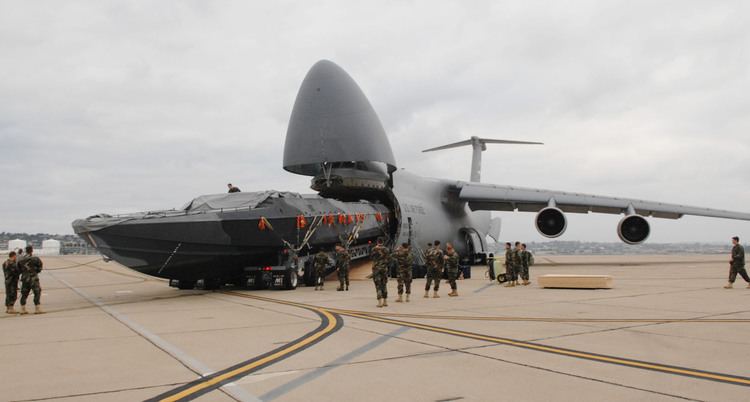
In 1961, several aircraft companies began studying heavy jet transport designs that would replace the Douglas C-133 Cargomaster and complement Lockheed C-141 Starlifters. In addition to higher overall performance, the United States Army wanted a transport aircraft with a larger cargo bay than the C-141, whose interior was too small to carry a variety of their outsized equipment. These studies led to the "CX-4" design concept, but in 1962 the proposed six-engine design was rejected, because it was not viewed as a significant advance over the C-141. By late 1963, the next conceptual design was named CX-X. It was equipped with four engines, instead of six engines in the earlier CX-4 concept. The CX-X had a gross weight of 550,000 pounds (249,000 kg), a maximum payload of 180,000 lb (81,600 kg) and a speed of Mach 0.75 (500 mph or 805 km/h). The cargo compartment was 17.2 ft (5.24 m) wide by 13.5 feet (4.11 m) high and 100 ft (30.5 m) long with front and rear access doors. To meet the power and range specifications with only four engines required a new engine with dramatically improved fuel efficiency.
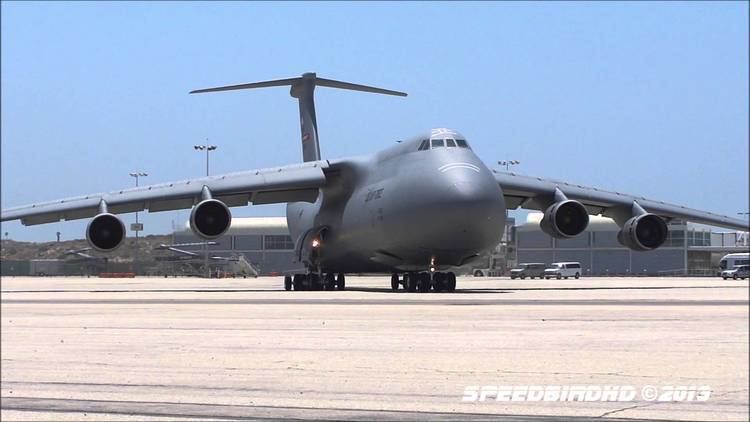
The criteria were finalized and an official request for proposal was issued in April 1964 for the "Heavy Logistics System" (CX-HLS) (previously CX-X). In May 1964, proposals for aircraft were received from Boeing, Douglas, General Dynamics, Lockheed, and Martin Marietta. General Electric, Curtiss-Wright, and Pratt & Whitney submitted proposals for the engines. After a downselect, Boeing, Douglas and Lockheed were given one-year study contracts for the airframe, along with General Electric and Pratt & Whitney for the engines. All three of the designs shared a number of features. The cockpit was placed well above the cargo area to allow for cargo loading through a nose door. The Boeing and Douglas designs used a pod on the top of the fuselage containing the cockpit, while the Lockheed design extended the cockpit profile down the length of the fuselage, giving it an egg-shaped cross section. All of the designs had swept wings, as well as front and rear cargo doors allowing simultaneous loading and unloading. Lockheed's design featured a T-tail, while the designs by Boeing and Douglas had conventional tails.
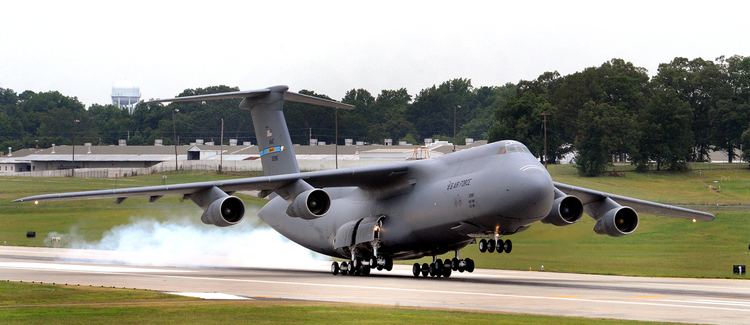
The Air Force considered Boeing's design to be better than that of Lockheed, but Lockheed's proposal was the lowest total cost bid. Lockheed was selected the winner in September 1965, then awarded a contract in December 1965. General Electric's TF39 engine was selected in August 1965 to power the new transport plane. At the time GE's engine concept was revolutionary, as all engines beforehand had a bypass ratio of less than two-to-one, while the TF39 promised and would achieve a ratio of eight-to-one, which had the benefits of increased engine thrust and lower fuel consumption.
Into production
The first C-5A Galaxy (serial number 66-8303) was rolled out of the manufacturing plant in Marietta, Georgia, on 2 March 1968. On 30 June 1968, flight testing of the C-5A began with the first flight, flown by Leo Sullivan, with the call sign "eight-three-oh-three heavy". Flight tests revealed that the aircraft exhibited a higher drag divergence Mach number than predicted by wind tunnel data. The maximum lift coefficient measured in flight with the flaps deflected 40-degrees was higher than predicted (2.60 vs. 2.38), but was lower than predicted with the flaps deflected 25 degrees (2.31 vs. 2.38) and with the flaps retracted (1.45 vs. 1.52).
Aircraft weight was a serious issue during design and development. At the time of the first flight, the weight was below the guaranteed weight, but by the time of the delivery of the 9th aircraft, had exceeded guarantees. In July 1969, during a fuselage upbending test, the wing failed at 128% of limit load, which is below the requirement that it sustain 150% of limit load. Changes were made to the wing, but during a test in July 1970, it failed at 125% of limit load. A passive load reduction system, involving uprigged ailerons was incorporated, but the maximum allowable payload was reduced from 220,000 to 190,000 lb (100,000 to 86,000 kg). At the time, it was predicted that there was a 90% probability that no more than 10% of the fleet of 79 airframes would reach their fatigue life of 19,000 hours without cracking of the wing.
Cost overruns and technical problems of the C-5A were the subject of a congressional investigation in 1968 and 1969. The C-5 program has the dubious distinction of being the first development program with a one billion dollar overrun. Due to the C-5's troubled development, the Department of Defense abandoned Total Package Procurement. In 1969, Henry Durham raised concerns about the C-5 production process with Lockheed, his employer. Subsequently, Durham was transferred and subjected to abuse until he resigned. The Government Accountability Office (GAO) substantiated some of his charges against Lockheed. Later, the American Ethical Union honored Durham with the Elliott-Black Award. The Deputy Assistant Secretary of the Air Force for Management Systems, Ernest Fitzgerald, was another person whose fostering of public accountability was unwelcome.
Upon completion of testing in December 1969, the first C-5A was transferred to the Transitional Training Unit at Altus Air Force Base, Oklahoma. Lockheed delivered the first operational Galaxy to the 437th Airlift Wing, Charleston Air Force Base, SC, in June 1970. Due to higher than expected development costs, in 1970 there were public calls for the government to split the substantial losses that Lockheed was experiencing. Production was nearly brought to a halt in 1971 due to Lockheed going through financial difficulties, due in part to the C-5 Galaxy's development as well as a civilian jet liner, the Lockheed L-1011. The U.S. government gave loans to Lockheed to keep the company operational.
In the early 1970s, NASA considered the C-5 for the Shuttle Carrier Aircraft role, to transport the Space Shuttle to Kennedy Space Center. However, they rejected it in favor of the Boeing 747, in part due to the 747's low-wing design. In contrast, the Soviet Union chose to transport its shuttles using the high-winged An-225, which derives from the An-124, which is similar in design and function to the C-5.
During static and fatigue testing cracks were noticed in the wings of several aircraft, and as a consequence the C-5A fleet was restricted to 80% of maximum design loads. To reduce wing loading, load alleviation systems were added to the aircraft. By 1980, payloads were restricted to as low as 50,000 lb (23,000 kg) for general cargo during peacetime operations. A $1.5 billion program, known as H-Mod, to re-wing the 76 completed C-5As to restore full payload capability and service life began in 1976. After design and testing of the new wing design, the C-5As received their new wings from 1980 to 1987. During 1976, numerous cracks were also found in the fuselage along the upper fuselage on the centerline, aft of the refueling port, extending back to the wing. The cracks required a redesign to the hydraulic system for the visor, the front cargo entry point.
Restarted production and development
In 1974, Iran, then having good relations with the United States, offered $160 million to restart C-5 production to enable Iran to purchase aircraft for their own air force, in a similar climate as to their acquisition of F-14 Tomcat fighters. However no C-5 aircraft were ever ordered by Iran, as the prospect was firmly halted by the Iranian Revolution in 1979.
As part of President Ronald Reagan's military policy, funding was made available for expansion of the USAF's airlift capability. With the C-17 program still some years from completion, Congress approved funding for a new version of the C-5, the C-5B, in July 1982 to expand airlift capacity. The first C-5B was delivered to Altus Air Force Base in January 1986. In April 1989, the last of 50 C-5B aircraft was added to the 77 C-5As in the Air Force's airlift force structure. The C-5B includes all C-5A improvements and numerous additional system modifications to improve reliability and maintainability.
In 1998, the Avionics Modernization Program (AMP) began upgrading the C-5's avionics to include a glass cockpit, navigation equipment, and a new autopilot system. Another part of the C-5 modernization effort is the Reliability Enhancement and Re-engining Program (RERP). The program will mainly replace the engines with newer, more powerful ones.
A total of 52 C-5s are contracted to be modernized, consisting of 49 B-, two C- and one A-model aircraft through the Reliability Enhancement and Re-Engining Program (RERP). The program features over 70 changes and upgrades, including the newer General Electric engines. Three C-5s underwent RERP for testing purposes. Low-rate initial production started in August 2009 with Lockheed reaching full production in May 2011. 22 C-5M Super Galaxies have been completed as of August 2014. The RERP upgrade program is to be completed in early 2018.
As of 2014 Lockheed is investigating drag reduction by plasma-heating of turbulent transonic airflow in critical points, saving overall weight by reducing fuel consumption. The Air Force Research Laboratory is looking at shape-memory alloy for speed dependent vortex generators.
Overview
The C-5 is a large high-wing cargo aircraft with a distinctive high T-tail fin (vertical) stabilizer, and with four TF39 turbofan engines mounted on pylons beneath wings that are swept 25 degrees. Similar in layout to its smaller predecessor, the C-141 Starlifter, the C-5 has 12 internal wing tanks and is equipped for aerial refueling. Above the plane-length cargo deck, it provides an upper deck for flight operations and for seating 75 passengers including the embarked loadmaster crew, all who face to the rear of the aircraft during flight. Full-open(able) bay doors at both nose and tail enable "drive-through" loading and unloading of cargo.
The cargo hold of the C-5 is one foot longer than the entire length of the first powered flight by the Wright Brothers at Kitty Hawk. For its voracious consumption of fuel and its maintenance and reliability issues the Galaxy's aircrews have nicknamed it FRED, for: Fucking Ridiculous, Economic/Environmental Disaster.
Takeoff and landing distance requirements for the plane at maximum-load gross weight are 8,300 ft (2,500 m) and 4,900 ft (1,500 m), respectively. Its high flotation main landing gear provides 28 wheels to distribute gross weight on paved or earth surfaces. The rear main landing gear can be made to caster to make a smaller turning radius, and rotates 90 degrees after takeoff before being retracted. "Kneeling" landing gear permits lowering the aircraft when parked, thereby presenting the cargo deck at truck-bed height to facilitate loading and unloading operations.
The C-5 features a Malfunction Detection Analysis and Recording (MADAR) system to identify errors throughout the aircraft.
The cargo compartment is 121 ft (37 m) long, 13.5 ft (4.1 m) high, and 19 ft (5.8 m) wide, or just over 31,000 cu ft (880 m3). It can accommodate up to 36 463L master pallets or a mix of palletized cargo and vehicles. The nose and aft cargo-bay doors open the full width and height of the cargo bay to maximize efficient loading of oversized equipment. Full width ramps enable loading double rows of vehicles from either end of the cargo hold.
The Galaxy C-5 is capable of moving nearly every type of military combat equipment, including such bulky items as the Army armored vehicle launched bridge (AVLB), at 74 short tons (67 t) , from the United States to any location on the globe; and of accommodating up to six Boeing AH-64 Apache helicopters or five Bradley Fighting Vehicles at one time.
Operational history
The first C-5A was delivered to the USAF on 17 December 1969. Wings were built up in the early 1970s at Altus AFB, Oklahoma; Charleston AFB, South Carolina; Dover AFB, Delaware; and Travis AFB, California. The C-5's first mission was on 9 July 1970, in Southeast Asia during the Vietnam War. C-5s were used to transport equipment and troops, including Army tanks and even some small aircraft, throughout the later years of the US action in Vietnam. In the final weeks of the war, prior to the Fall of Saigon, several C-5s were involved in evacuation efforts. During one such mission a C-5A crashed while transporting a large number of orphans, with over 140 killed.
C-5s have also been used to deliver support and reinforce various US allies over the years. During the Yom Kippur war in 1973, multiple C-5s and C-141 Starlifters delivered critical supplies of ammunition, replacement weaponry and other forms of aid to Israel, the US effort was named as Operation Nickel Grass. The C-5 Galaxy's performance in Israel was such that the Pentagon began to consider further purchases. The C-5 was regularly made available to support American allies, such as the British-led peacekeeper initiative in Zimbabwe in 1979.
On 24 October 1974, the Space and Missile Systems Organization successfully conducted an Air Mobile Feasibility Test where a C-5A Galaxy aircraft air dropped an 86,000 lb Minuteman ICBM from 20,000 ft over the Pacific Ocean. The missile descended to 8,000 ft before its rocket engine fired. The 10-second engine burn carried the missile to 20,000 ft again before it dropped into the ocean. The test proved the feasibility of launching an intercontinental ballistic missile from the air. Operational deployment was discarded due to engineering and security difficulties, though the capability was used as a negotiating point in the Strategic Arms Limitation Talks. Aircraft 69-0014, "Zero-One-Four" used in the test was retired to the Air Mobility Command Museum at Dover Air Force Base.
The C-5 has been used for several unusual functions. During the development of the secretive stealth fighter, the Lockheed F-117 Nighthawk, Galaxies were often used to carry partly disassembled aircraft, leaving no exterior signs as to their cargo. The C-5 remains the largest aircraft to operate in the Antarctic, capable of operating from Williams Field near McMurdo Station. The C-5 Galaxy was a major supply asset in the international coalition operations in 1990-91 against Iraq in the Gulf War. C-5s have routinely delivered relief aid and humanitarian supplies to areas afflicted with natural disasters or crisis, multiple flights were made over Rwanda in 1994.
The wings on the C-5As were replaced during the 1980s to restore full design capability. The USAF took delivery of the first C-5B on 28 December 1985 and the final one in April 1989. The reliability of the C-5 fleet has been a continued issue throughout its lifetime, however the C-5M upgrade program seeks in part to address this issue. Their strategic airlift capacity has been a key logistical component of U.S. military operations in Afghanistan and Iraq. Following an incident during Operation Iraqi Freedom where one C-5 was damaged by a projectile, the installation of defensive systems has become a stated priority.
The C-5 AMP and RERP modernization programs plan to raise mission-capable rate to a minimum goal of 75%. Over the next 40 years, the U.S. Air Force estimates the C-5M will save over $20 billion. The first C-5M conversion was completed on 16 May 2006 and C-5Ms began test flights at Dobbins Air Reserve Base in June 2006. The USAF decided to convert remaining C-5Bs and C-5Cs into C-5Ms with avionics upgrades and re-engining in February 2008. The C-5As will receive only the avionics upgrades.
In response to Air Force plans to retire older C-5 aircraft, Congress implemented legislation that set limits on retirement plans for C-5As in 2003. As of November 2013, 45 C-5As have been retired, 11 have been scrapped, parts of one (A/C 66-8306) are now a cargo load trainer at Lackland AFB, Texas and one was sent to the Warner Robins Air Logistics Center (WR-ALC) for tear down and inspection to evaluate structural integrity and estimate the remaining life for the fleet.
The U.S. Air Force began to receive refitted C-5M aircraft in December 2008. Full production of C-5Ms began in the summer of 2009. In 2009, the Congressional ban on the retirement of C-5s was overturned. The Air Force seeks to retire one C-5A for each 10 new C-17s ordered. In October 2011, the 445th Airlift Wing based at Wright-Patterson Air Force Base replaced all remaining C-5s with C-17s. The C-5M reached initial operating capability (IOC) on 24 February 2014 with 16 aircraft delivered.
On 13 September 2009, a C-5M set 41 new records and flight data was submitted to the National Aeronautic Association for formal recognition. The C-5M had carried a payload of 176,610 lb (80,110 kg) to over 41,100 ft (12,500 m) in 23 minutes, 59 seconds. Additionally, 33 time to climb records at various payload classes were set, and the world record for greatest payload to 6,562 ft (2,000 m) was broken. The aircraft was in the category of 551,200 to 661,400 lb (250,000 to 300,000 kg) with a takeoff weight of 649,680 lb (294,690 kg) including payload, fuel, and other equipment.
C-5A
The C-5A is the original version of the C-5. From 1969 to 1973, 81 C-5As were delivered to U.S. Air Force bases. Due to cracks found in the wings in the mid-1970s, the cargo weight was restricted. To restore the C-5's full capability, the wing structure was redesigned. A program to install new strengthened wings on 77 C-5As was conducted from 1981 to 1987. The redesigned wing made use of a new aluminum alloy that did not exist during the original production. As of August 2016, there are 10 A-models in service flown by the Air Force Reserve Command 433d Airlift Wing at Lackland AFB, Texas and 439th Airlift Wing at Westover ARB, Massachusetts.
C-5B
The C-5B is an improved version of the C-5A. It incorporated all modifications and improvements made to the C-5A with improved wings, simplified landing gear, upgraded TF-39-GE-1C turbofan engines and updated avionics. 50 of the new variant were delivered to the U.S. Air Force from 1986 to 1989.
C-5C
The C-5C is a specially modified variant for transporting large cargo. Two C-5s (68-0213 and 68-0216) were modified to have a larger internal cargo capacity to accommodate large payloads, such as satellites. The major modifications were the removal of the rear passenger compartment floor, splitting the rear cargo door in the middle, and installing a new movable aft bulkhead further to the rear. The official C-5 technical manual refers to the version as C-5A(SCM) Space Cargo Modified. Modifications also included adding a second inlet for ground power, which can feed any power-dependent equipment that may form part of the cargo. The two C-5Cs are operated by U.S. Air Force crews for DOD spacecraft programs and NASA, and are stationed at Travis AFB, California. Both 68-0213 and 68-0216 completed the Avionics Modernization Program by January 2007. 68-0213 is being upgraded in RERP to the C-5M (SCM) standard.
C-5 AMP and C-5M Super Galaxy
Following a study showing 80% of the C-5 airframe service life remaining, AMC began an aggressive program to modernize all remaining C-5Bs and C-5Cs and many of the C-5As. The C-5 Avionics Modernization Program (AMP) began in 1998 and includes upgrading avionics to Global Air Traffic Management compliance, improving communications, new flat panel displays, improving navigation and safety equipment, and installing a new autopilot system. The first flight of a C-5 with AMP (85-0004) occurred on 21 December 2002.
The Reliability Enhancement and Re-engining Program (RERP) began in 2006. It includes new General Electric F138-GE-100 (CF6-80C2) engines, pylons and auxiliary power units, upgrades to aircraft skin and frame, landing gear, cockpit and pressurization systems. Each CF6 engine produces 22% more thrust (50,000 lbf or 220 kN), providing a 30% shorter takeoff, a 38% higher climb rate to initial altitude, an increased cargo load and a longer range. Upgraded C-5s are designated C-5M Super Galaxy.
L-500
Lockheed also planned a civilian version of the C-5 Galaxy, the L-500, the company designation also used for the C-5 itself. Both passenger and cargo versions of the L-500 were designed. The all-passenger version would have been able to carry up to 1,000 travelers, while the all-cargo version was predicted to be able to carry typical C-5 volume for as little as 2 cents per ton-mile (in 1967 dollars). Although some interest was expressed by carriers, no orders were placed for either L-500 version, due to operational costs caused by low fuel efficiency, a significant concern for a profit-making carrier, even before the oil crisis of the 1970s, keen competition from Boeing's 747, and high costs incurred by Lockheed in developing the C-5 and later, the L-1011 which led to the governmental rescue of the company.
C-5 Shuttle Carrier
Lockheed proposed a twin body C-5 as a Shuttle Carrier Aircraft to counter the Conroy Virtus, but the design was turned down in favor of the Boeing 747.
Operators
United States Air Force
The C-5 is limited to military and government use. The U.S. Air Force has 57 C-5s in service as of December 2015. It plans to reduce the fleet to 52 C-5Ms by 2017.Military Airlift Command / Air Mobility Command
Air Education & Training Command
Air Force Reserve
Air National Guard
Incidents and accidents
There have been three C-5 Galaxy aircraft lost in crashes along with two class-A losses resulting from ground fire, with a combined total of 169 fatalities. There have been at least two other C-5 crashes that resulted in major airframe damage, but the aircraft were repaired and returned to service.
Notable accidents
Aircraft on display
C-5A, AF Ser. No. 69-0014, is on display at the Air Mobility Command Museum at Dover Air Force Base, Delaware. This is the first, and currently only, C-5 aircraft to go on museum display.
Specifications (C-5B)
Data from Quest for Performance, International Directory of Military Aircraft, and USAF fact sheet
General characteristics
4 minimum (pilot, copilot, two flight engineers)
Performance
